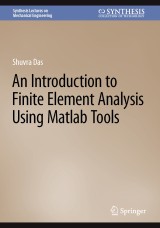Details

An Introduction to Finite Element Analysis Using Matlab Tools
Synthesis Lectures on Mechanical Engineering
|
CHF 94.50 |
|
| Verlag: | Springer |
| Format: | |
| Veröffentl.: | 23.03.2023 |
| ISBN/EAN: | 9783031175404 |
| Sprache: | englisch |
Dieses eBook enthält ein Wasserzeichen.
Beschreibungen
This book is an attempt to develop a guide for the user who is interested in learning the method by doing. There is enough discussion of some of the basic theory so that the user can get a broad understanding of the process. And there are many examples with step-by-step instructions for the user to quickly develop some proficiency in using FEA. We have used Matlab and its PDE toolbox for the examples in this text. The syntax and the modeling process are easy to understand and a new user can become productive very quickly. The PDE toolbox, just like any other commercial software, can solve certain classes of problems well but is not capable of solving every type of problem. For example, it can solve linear problems but is not capable of handling non-linear problems. Being aware of the capabilities of any tool is an important lesson for the user and we have, with this book, tried to highlight that lesson as well.<p></p><p> </p>
Chapter 1 - Introduction.- Chapter 2 - Discrete Finite Elements.- Chapter 3 - Finite Elements for the Continuum, Heat Transfer problems.- Chapter 4 - The FEA Process.- Chapter 5 - Stress Analysis Problems.- Chapter 6 - Special Problems.<p></p>
<p> </p>
<p> </p>
<p>Dr. Shuvra Das started working at the University of Detroit Mercy in January 1994 and is currently a Professor of Mechanical Engineering. Over this time, he served in a variety of administrative roles such as Mechanical Engineering Department Chair, Associate Dean for Research and Outreach, and Director of International Programs in the College of Engineering and Science. He has an undergraduate degree in Mechanical Engineering from the Indian Institute of Technology, and a Master’s and Ph.D. in Engineering Mechanics from Iowa State University. He was a post-doctoral researcher at the University of Notre Dame and worked in the industry for several years prior to joining Detroit Mercy. </p>
<p>Dr. Das has taught a variety of courses ranging from freshmen to advanced graduate levels such as Mechanics of Materials, Introductory and Advanced Finite Element Method, Engineering Design, Introduction to Mechatronics, Mechatronic Modeling and Simulation, Mathematics for Engineers, Electric Drives and Electromechanical Energy Conversion. He led the effort in the college to start several successful programs: an undergraduate major in Robotics and Mechatronic Systems Engineering, a graduate certificate in Advanced Electric Vehicles, and thriving partnerships for student exchange with several universities in China. <br></p>
<p>Dr. Das received many awards for teaching and research at Detroit Mercy as well as from organizations outside the university. His areas of research interest are modeling and simulation of multi-disciplinary engineering problems, engineering education, and curriculum reform. He has worked in areas ranging from mechatronics system simulation to multi-physics process simulation using CAE tools such as Finite Elements and Boundary Elements. He has authored or co-authored five published books on these topics.<br></p>
<p> </p>
<p>Dr. Das has taught a variety of courses ranging from freshmen to advanced graduate levels such as Mechanics of Materials, Introductory and Advanced Finite Element Method, Engineering Design, Introduction to Mechatronics, Mechatronic Modeling and Simulation, Mathematics for Engineers, Electric Drives and Electromechanical Energy Conversion. He led the effort in the college to start several successful programs: an undergraduate major in Robotics and Mechatronic Systems Engineering, a graduate certificate in Advanced Electric Vehicles, and thriving partnerships for student exchange with several universities in China. <br></p>
<p>Dr. Das received many awards for teaching and research at Detroit Mercy as well as from organizations outside the university. His areas of research interest are modeling and simulation of multi-disciplinary engineering problems, engineering education, and curriculum reform. He has worked in areas ranging from mechatronics system simulation to multi-physics process simulation using CAE tools such as Finite Elements and Boundary Elements. He has authored or co-authored five published books on these topics.<br></p>
<p> </p>
This book is an attempt to develop a guide for the user who is interested in learning the method by doing. There is enough discussion of some of the basic theory so that the user can get a broad understanding of the process. And there are many examples with step-by-step instructions for the user to quickly develop some proficiency in using FEA. We have used Matlab and its PDE toolbox for the examples in this text. The syntax and the modeling process are easy to understand and a new user can become productive very quickly. The PDE toolbox, just like any other commercial software, can solve certain classes of problems well but is not capable of solving every type of problem. For example, it can solve linear problems but is not capable of handling non-linear problems. Being aware of the capabilities of any tool is an important lesson for the user and we have, with this book, tried to highlight that lesson as well.
Learning-by-doing approach Examples with step-by-st instructions for quick proficiency in using FEA Showcases Matlab capabilities that an be used to solve FEA problems
Diese Produkte könnten Sie auch interessieren:

Neutron Applications in Earth, Energy and Environmental Sciences

von: Liyuan Liang, Romano Rinaldi, Helmut Schober

CHF 177.00

Nanobioelectronics - for Electronics, Biology, and Medicine

von: Andreas Offenhäusser, Ross Rinaldi

CHF 118.00














